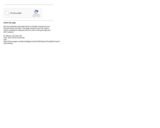
This is a handout I have used to help faculty identify and use Open Educational Resources.
- Subject:
- Education
- Material Type:
- Diagram/Illustration
- Author:
- David O. Smith
- Date Added:
- 02/02/2021

This is a handout I have used to help faculty identify and use Open Educational Resources.
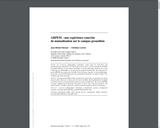
Les ressources pédagogiques numériques créées dans les universités sont actuellement peu mutualisées. Les raisons que nous avançons sont leur manque de visibilité, la fragilité inhérente aux documents numériques, l absence historique de gestion de ce type d objets par les bibliothèques et les questions de propriété intellectuelle. Nous présentons le projet ARPEM, mis en place par Grenoble Universités pour répondre à cette problématique. Les premiers mois de fonctionnement nous permettent de présenter un rapport d étape et les évolutions prévisibles du projet.
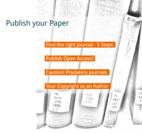
The aim of this toolkit is to support early career researchers in finding a journal that publishes their paper and optimally promotes the visibility of their research. How can they find a journal with a good journal ranking score that is perceived in the respective research community? How can they find a journal that perfectly matches their topic? Should they consider publishing open access? What are predatory journals and how can they detect them?
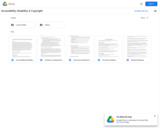
These materials are intended to be used both in graduate courses related to copyright or accessibility and by practitioners interested in learning more on the topic. Topics covered include the Chafee Amendment and how it has changed post-Marrakesh Treaty, the role of accessibility in the Authors Guild, Inc. v. HathiTrust decision, the importance of the Marrakesh Treaty for international efforts to make materials accessible across borders, and how licensing provisions can impact these various rights. The resources include videos explaining the key points of each topic, along with editable slide decks for those who wish to build on the existing materials, activities and options for assignments, recommended pre-class readings, discussion prompts, and related resources for those who want to learn more on the topics introduced in this OER module. There are also teaching notes for those interested in using the module in a class they are teaching.
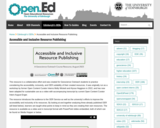
The resource introduces the audience to the OER Service as well as the university’s efforts to improve the accessibility and inclusivity of its resources. By looking at and together analysing three already published OER (all listed below), learners are taught what points to keep in mind as they are creating their own resources. The resource is available as a video and in transcript format with PowerPoint slides embedded.
This resource is a collaborative effort and was created for Geoscience Outreach students to practice considering the accessibility, inclusivity, and OER suitability of their created resources. It was originally run as a workshop by Open Content Curator Interns Molly Wickett and Alyssa Heggison in 2022, and has now been adapted for sustainable use as a video with accompanying transcript by an Intern August Enger in 2023.
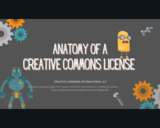
A brief overview of the six Creative Commons licenses and how each works.
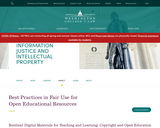
As educators begin to develop OER, one component of that process is navigating concerns around copyright when finding digital teaching materials. This webinar series addresses that and is divided into two tracks: K-12 and Higher Education. There are also two stand-alone webinar options that can be attended by both the K-12 and Higher Education community. All of the webinars will also be available on YouTube and linked to this page after the live event has ended.
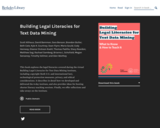
For those learning about fair use, this is a specific example of how fair use may be used in research for text data mining. The book also explores basic copyright and fair use more generally, as well as the specifics of text data mining.
From the "about" section of the book:
"This book explores the legal literacies covered during the virtual Building Legal Literacies for Text Data Mining Institute, including copyright (both U.S. and international law), technological protection measures, privacy, and ethical considerations. It describes in detail how we developed and delivered the 4-day institute, and also provides ideas for hosting shorter literacy teaching sessions. Finally, we offer reflections and take-aways on the Institute."
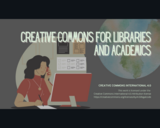
This module takes a look at the advantages of OER and the Creative Commons for both instructors and their learners. Both instructors and learners can enjoy using OER as well as creating it for use by others!

Creative Commons is an open license that actually works with Copyright with a slant to copyleft.
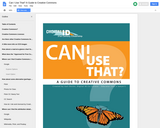
This guide, created by Gail Desler, is a quick overview of Creative Commons, what the license symbols mean, how to find images that are okay to use in projects, and more!

This will set a standard for student's academic integrity and dishonesty in submitting their papers and/or presentations.
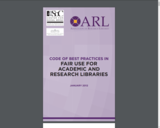
This is a code of best practices in fair use devised specifically by and for the academic
and research library community. It enhances the ability of librarians to rely on fair
use by documenting the considered views of the library community about best
practices in fair use, drawn from the actual practices and experience of the library
community itself.

This course provides an introduction to the technology and policy context of public communications networks, through critical discussion of current issues in communications policy and their historical roots. The course focuses on underlying rationales and models for government involvement and the complex dynamics introduced by co-evolving technologies, industry structure, and public policy objectives. Cases drawn from cellular, fixed-line, and Internet applications include evolution of spectrum policy and current proposals for reform; the migration to broadband and implications for universal service policies; and property rights associated with digital content. The course lays a foundation for thesis research in this domain.
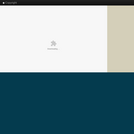
In using copyright works (e.g. journals or newspaper articles, books, photographs, music) for study or research you are expected to observe certain legal and ethical constraints. In particular, you are bound to abide by the law of copyright.
This resource helps you to see how copyright could affect the way you study, research and work while at university.
This resource is suitable for all levels of study.

This course is for educators and learners who wants to understand how copyright affects use of learning materials, and how to use copyright to facilitate education. The course is focused on developing practical solutions. The reading won't always give these to you, its up to you to devise practical solutions based on the reading.
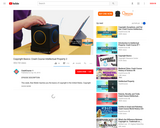
This week, Stan Muller teaches you the basics of copyright in the United States. Copyright law is territorial, so we're going to cover the system we know the most about, and that's the US. Stan will talk about what kind of ideas can be copyrighted, who can get a copyright, and what protections the copyright grants. We'll also talk about the always contentious and seemingly ever-growing term of copyright. Stan will also teach you about the low bar for creativity, which means that original work doesn't have to be all that original, and he'll also touch on the problems with copyright in the modern world.

Information about how to determine whether a published work between 1923 and 1978 is in the public domain.

The Copyright Crash Course was created by Georgia Harper and is currently maintained by UT Libraries. The Course is arranged into several sections that allow users to explore certain areas of copyright law individually or as a group. The Course was originally created with faculty in mind, but can be used by anyone who is interested in understanding and managing their copyrights.
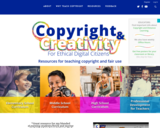
These materials aim to provide accessible and practical information about copyright – its protections, its limitations, and its role in encouraging creativity. Rather than just emphasizing what copyright prohibits, the goal here is to offer useful and positive information about what copyright allows and how students can successfully navigate and rely on copyright in their own roles as creators.
It is important to note that these materials focus on copyright in the United States. Other countries have similar frameworks, but their rules may differ on certain concepts such as fair use.
Lessons for students in grades K-12 are provided in pdf and google slide format.